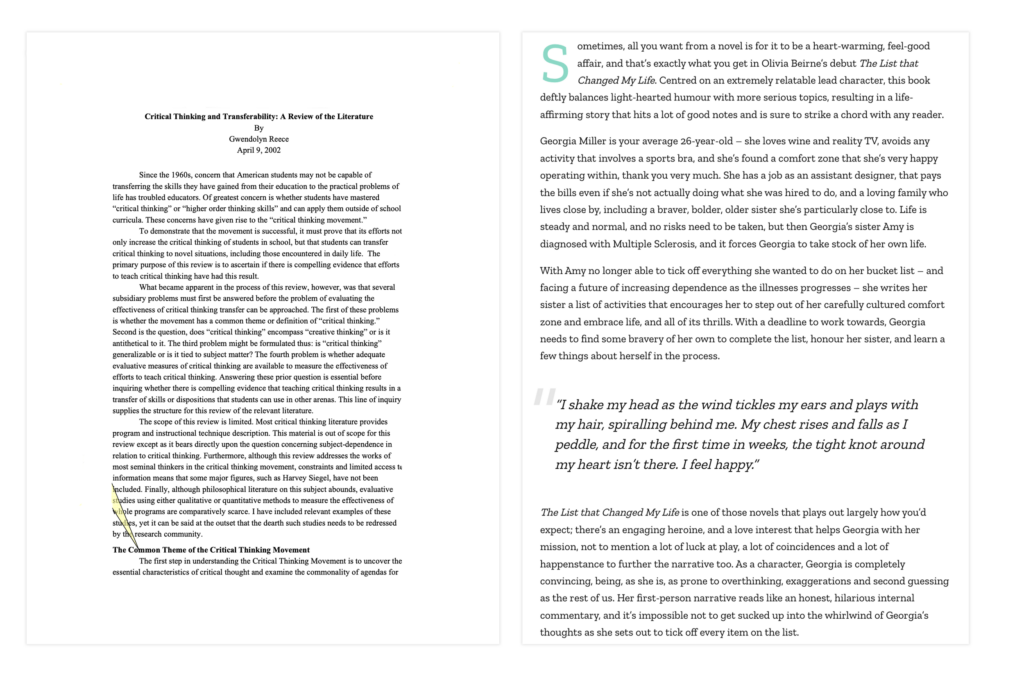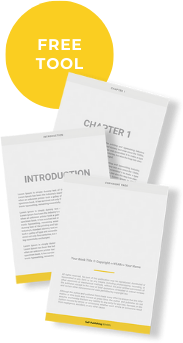Looking to learn how to write a literature review? You’re in the right place. There are a lot of ways you can go about it, but not many are as clear and straightforward as you’ll get here.
Literature reviews are different from other types of reviews, like book reviews. People reading them will expect something with separate requirements, so it’s important to understand the differences, what goes into it, and even the purpose.
Here’s what you’ll learn about how to write a literature review:
- Literature review VS normal
- Purpose of a literature review
- When you’d need one
- How to write a literature review
- Tools to help
What’s a literature review VS a normal review?
A literature review differs from a normal review in its focus and scope. While a normal review typically evaluates a single work, such as a book, movie, or product, based on personal opinion or specific criteria, a literature review examines and synthesizes existing research and scholarship on a particular topic. If you want to learn how to write a literature review, keep in mind that it’s more formal than a book review you’d find online.
This is especially relevant when college students are assigned this for school purposes.
A literature review aims to provide an overview of the current state of knowledge, identify gaps or areas for further research, and support the development of new research or scholarly work. In contrast, a normal book review is more focused on informing or persuading a broader audience about the merits or shortcomings of a specific work.
As you can see in the image below, a literature review (left) contains a much more formal and less opinion-based writing style as opposed to a normal book review (right).

What’s the purpose of a literature review?
Before diving into the process of writing a literature review, it’s crucial to understand its purpose. While you’ll likely only write literature reviews in places like college, you may find it necessary to write them during other times too.
A literature review serves several purposes, including:
- Providing a comprehensive overview of existing research and scholarship related to your topic.
- Identifying gaps, contradictions, or areas for further study in the existing literature.
- Establishing the relevance and significance of your research question or topic.
- Demonstrating your familiarity with the relevant theories, methodologies, and approaches in your field.
Without knowing how to write a literature review the right way, though, these purposes become pointless. Because its purpose will dictate how you write a literature review, what you research, what’s included, and ultimately the entire outcome of the review itself.
When would you need to write a literature review?
There are several times you’d need to write a literature review, for the purposes listed above. Don’t think you’ll ever need to know how to do it? Think again.
These are the primary times you’d need to write one:
- For theses and dissertations: A literature review is often a chapter in a thesis or dissertation, where you review and analyze the existing literature relevant to your research topic.
- Research Papers: In research papers, a literature review provides a comprehensive overview of the existing research on a particular topic, demonstrating the significance of the study.
- Grant Proposals: When applying for research grants, a literature review helps to establish the background and context for your proposed research, showing that it is novel and relevant.
- Academic Articles: Academic articles often include literature reviews to situate the author’s research within the broader scholarly conversation and to demonstrate familiarity with relevant literature.
- Policy Papers: In policy papers, a literature review may be used to summarize and analyze existing research relevant to a particular policy issue or question.
- Book Reviews: In some cases, book reviews may include a brief literature review to contextualize the book’s contribution to the field. You may also learn how to write a literature review to create more of a thought-piece that includes multiple books for the outcome you desire.
- Class Assignments: In academic courses, instructors may assign literature reviews to help students develop their research and writing skills and demonstrate their understanding of course material. This is a big reason many learn how to write a literature review.
How to Write a Literature Review & Cover All the Bases
Regardless of why you have to learn how to write a literature review, it’s time to dive in and get it done.
Keep in mind that over time, you’ll find ways to add your own flare to each of these steps, and what you aim to accomplish with your literature review will also be a piece of your perspective.
1. Define Your Scope and Objectives
Before you begin searching for sources, clarify the scope and objectives of your literature review. You’ll want to have a good idea of what you’ll need to research, the depth of that research, and what you want to accomplish.
Doing this helps you predict how much time you’ll spend in the research stage, and keeps your work singularly focused as you piece together your work. A big part of how to write a literature review has to do with maintaining your overall objective.
Here are a few questions to help you do this:
- What specific research question or problem are you addressing?
- What are the key themes or concepts you want to explore?
- What’s the effect you want the literature review to have?
- How much time do you have to finish it?
- What are the primary methods of research you have to use?
2. Conduct a Thorough Literature Search
Start by identifying relevant databases, journals, and other sources in your field. Use keywords related to your topic to search for relevant literature. Keep track of the sources you find and any notes or insights you gather.
These are all basic research steps that you should be able to do by now. But this is a great resource for learning how to do academic research.
Aside from that, here are a couple sites you can use to search deeply in order to get learning how to write a literature review right:
3. Evaluate and Select Sources
Once you have a list of potential sources, evaluate them based on their relevance, reliability, and significance to your research. Select sources that provide a diverse range of perspectives and insights on your topic.
Remember that to make a point and learn how to write a literature review that good and purposeful, it’s important to evaluate all the data and use conflicting evidence if necessary. Take what supports your claim, but also use data necessary to draw out the doubt readers may already have, and address it. Don’t run from it.
This is often the hard part of learning how to write a literature review, but necessary if you want to solidify your purpose.
4. Organize Your Literature Review
There are several ways to organize a literature review, depending on your research question and objectives.
Some common approaches include chronological, thematic, and theoretical frameworks. Choose an organization method that best suits your needs. Ultimately, you’ll want to reference the purpose of learning how to write a literature review in the first place. Whatever best serves your end goal will be the right way to go about it.
That said, we do have a bit of a structure for learning how to write a literature review.
Here’s how you can organize it:
- Introduction: Provide an overview of the topic, its importance, and the scope of the review. State the objective or purpose of the review and how you’ll back that up.
- Body:
- Background: Provide background information on the topic, including key concepts and definitions.
- Themes/Topics: Organize the literature into themes or topics that help to categorize and make sense of the existing research.
- Critical evaluation: Analyze and evaluate the literature. This can include comparing and contrasting different studies, discussing strengths and weaknesses, and identifying gaps in the research.
- Synthesis: Summarize the main findings and arguments of the literature, highlighting key points and trends.
- Theoretical framework: If applicable, discuss the theoretical framework(s) used in the literature and how they relate to your review.
- Conclusion: Summarize the main findings of the literature review and discuss their implications. Suggest areas for future research.
- References: Provide a list of all the sources cited in the literature review, following a consistent citation style (e.g., APA, MLA).
Reading other reviews is a great way to learn how to write a literature review the right way. You’ll better understand how to bridge concepts together with research.
5. Find the Patterns
As you read and analyze each source, look for key themes, patterns, and findings. Identify areas of agreement, disagreement, or controversy among the sources so you can use those in the body. This can be one of the most difficult components of knowing how to write a literature review. Being able to know what will work best to support your purpose isn’t always easy.
You can’t use everything. Synthesize the information to develop a coherent narrative that highlights the key points and debates in the literature.
6. Write Your Literature Review
Begin your literature review with an introduction that provides an overview of the topic and its significance.
Organize the body of the review based on your chosen organization method. If it makes sense for certain elements to be before others, even though they’re listed differently in the structure above, just go with your gut.
For each section, summarize the key findings and arguments of the sources, and explain how they relate to your research question or topic. Get a rough draft out, and don’t worry about getting it all perfect just yet. You’ll be able to refine it with time.
Take a few of our self-editing tips as you comb through. After all, learning how to write a literature review that’s purposeful often involves a lot of editing and refining.
7. Provide Critical Analysis
In addition to summarizing the literature, provide critical analysis and evaluation of the sources. Discuss the strengths and weaknesses of each source, and consider how they contribute to or detract from the overall body of knowledge on your topic.
This is the part where you truly learn how to write a literature review that’s not solely opinion-based. You’re able to be more objective about the findings, which makes for a more credible paper.
8. Conclude Your Literature Review
In your conclusion, summarize the key findings and arguments of the literature review. Discuss the implications of the existing research for your own study, and suggest directions for future research.
You can make it clear whether or not the purpose was fulfilled or if there needs to be additional research in the field in order to have a complete analysis. It’s okay if that’s the outcome you discover!
Remember, in order to learn how to write a literature review that’s authoritative, you may need to admit that the findings are inconclusive or biased one way or another.
Necessary Tools When Learning How to Write a Literature Review
We all love to make things easier. Learning how to write a literature review is no different.
Above, we listed a few websites to help with the research aspect, but here are a few additional tools to make the job easier:
- Reference Management Software: Tools like Zotero, Mendeley, and EndNote can help you organize and manage your sources, as well as generate citations and bibliographies.
- Mind Mapping Tools: Mind mapping tools like MindMeister or XMind can help you visualize the connections between different sources and ideas, making it easier to organize your literature review.
- Literature Review Matrix: A literature review matrix is a table that helps you organize and compare the key findings and arguments of different sources. You can create a matrix using spreadsheet software like Excel or Google Sheets.
- Writing and Editing Tools: Tools like Grammarly or Hemingway Editor can help you improve the clarity and readability of your writing, ensuring that your literature review is well-structured and free of errors.
It can take a while to write a good literature review. The steps above are a guide to help you generate something that’s clear, well researched, and proves a necessary point.


Book Outline Generator
Choose your Fiction or Nonfiction book type below to get your free chapter by chapter outline!
Book Outline Generator
Enter your details below and get your pre-formatted outline in your inbox and start writing today!
CONGRATULATIONS
Thanks for submitting! Check your email for your book outline template.
In the meantime, check out our Book Outline Challenge.
